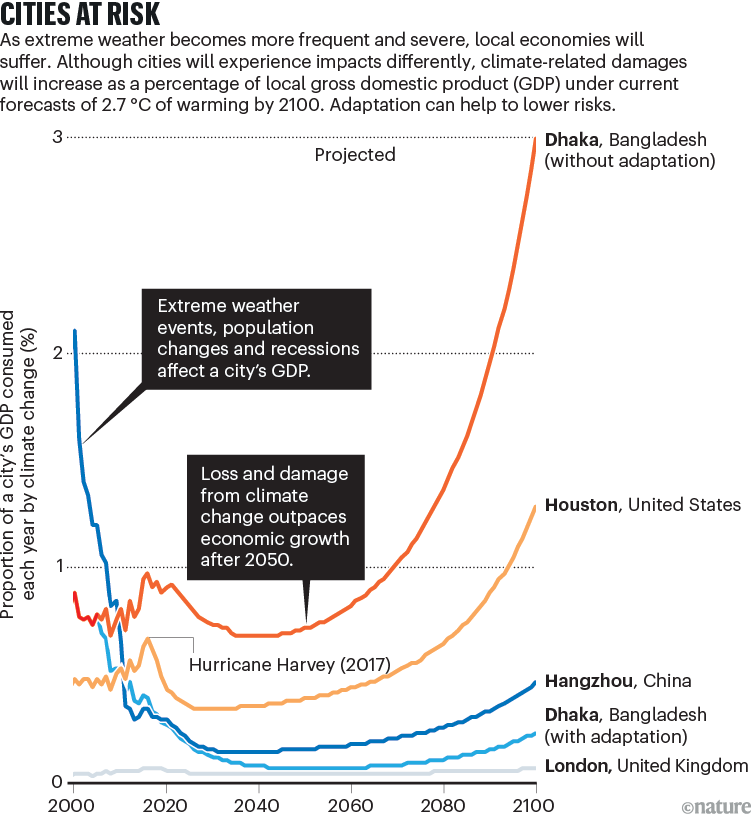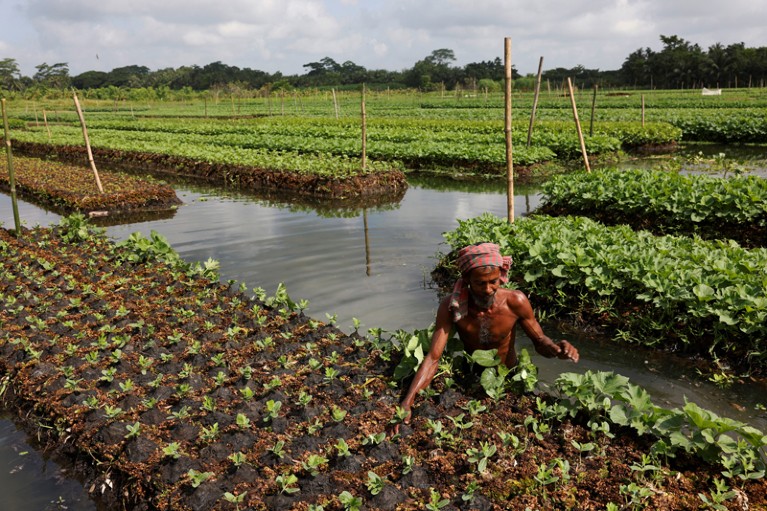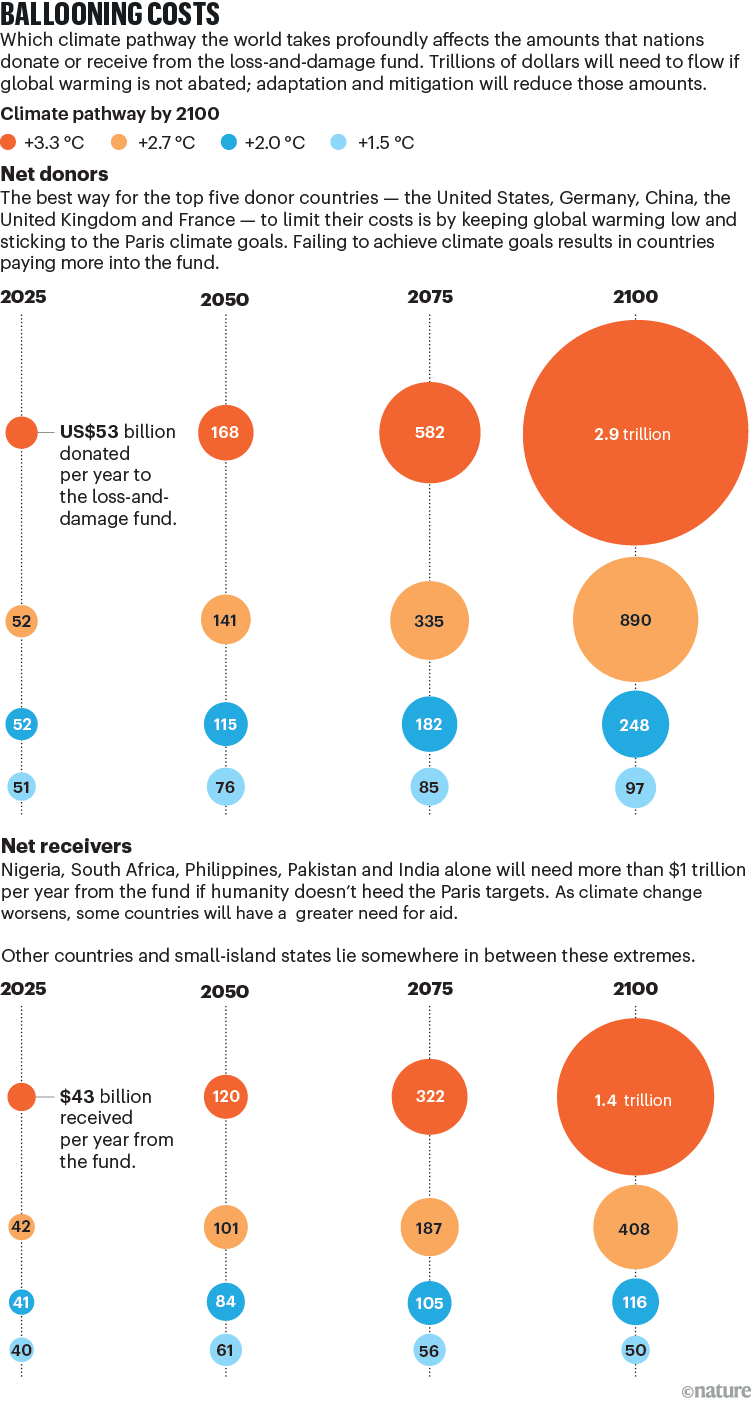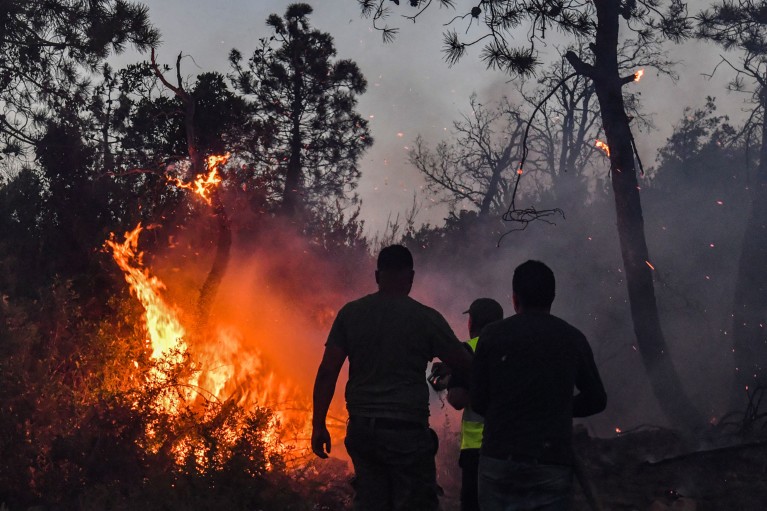This year has given ample evidence of how emerging economies are bearing the brunt of climate change. In February and March, Cyclone Freddy raged across the Indian Ocean for 5 weeks and made landfall 3 times, killing more than 1,400 people in Malawi and elsewhere in southeastern Africa. In July, Algeria experienced 50 °C heat and fires that killed dozens of people and displaced thousands. In September, more than 11,000 people died in the Libyan port city of Derna when a hurricane and torrential rains caused dams to burst1. Elsewhere, melting ice, rising seas, extreme heat and drought are wreaking havoc from the poles to small Pacific islands2 .
Demands for compensation3 for ‘loss and damage’ — the excess or permanent hit to ecosystems, infrastructure and culture from climate-change-related extremes — are mounting. Pakistan has raised a US$9-billion lifeline from some 40 countries as well as private donors and banks to rebuild after devastating floods affected 33 million people there in 2022. Other nations want similar support. The question is, who should pay and on what basis?
Answers must be found at the end of this month in Dubai, at the 28th Conference of the Parties (COP28) to the United Nations Framework Convention on Climate Change (UNFCCC). As agreed last year at COP27 in Egypt, negotiators are tasked with setting up a global funding mechanism to address loss and damage. It is still unclear how the process will work.
Thorny questions of climate justice lie at the heart of these issues. If a country has not contributed significantly to global emissions, why should it suffer the consequences of those who have? Is a developed economy, such as the United States, liable for the consequences of its historical emissions?
Climate loss-and-damage funding: how to get money to where it’s needed fast
To prevent politics from stalling the establishment of the fund, we propose that decisions about who pays (and how much they give) should be made on the basis of trusted data and analysis. Rather than making assessments on an event-by-event basis after damage has been caused, a global loss-and-damage fund needs to assess in advance which areas will be most hit by climate-change impacts, guided by models of physical risks. Dispersing funds accordingly in advance would mean that people on the ground have the money to deal with disasters when they come, or to invest in adaptation.
Here, we set out how such a system might work. There are three key steps: assessing how much climate change is affecting loss and damage in locations around the world; devising fair criteria for calculating payments to cope with the effects of global heating; and developing a trusted mechanism for managing the fund.
Assess the role of climate change in loss and damage
Natural disasters have always occurred. The pertinent question is the extent to which climate change is increasing their associated costs. Climate scientists are now adept at such ‘climate attribution’ and are able to apportion economic damage accordingly4. For example, in August 2017 in Texas, Hurricane Harvey caused damage amounting to $90 billion. Of this, around three-quarters, or $67 billion5, has been linked to climate change — which made rainfall during the event about 15% more intense, according to one analysis6. Some events are almost wholly caused by climate change7, such as the heatwave in June and July 2021 that led to 1,400 deaths in Canada and the US Pacific Northwest, generating almost $9 billion in damages in the United States alone.
‘Loss and damage’ – the most controversial words in climate finance today
However, such calculations rely on data from weather stations, which are scant in low- and middle-income countries. For example, for its population size and area, Africa should have a similar number to those in Europe and the United States combined, or around 600 radar weather stations; it has 378. Weather monitoring will need to be funded around the globe to support loss-and-damage calculations, as well as early warning systems and nowcasting (local forecasts up to six hours in advance) to limit damage and casualties.
The insurance and financial sectors already use models of physical risks to translate temperature anomalies into climate impacts and to project effects, usually in terms of the number of people displaced and the cost of damage. Such models are used to future-proof investments9. But they are proprietary, and would need upgrading to assess where loss-and-damage payments should go. Many components have yet to be added — including climatic trends such as El Niño and tipping points in Earth systems10. A UN-led effort would need transparent software code for models, and hefty data processing.
Devise fair criteria for calculating financial support
Even once a region’s intrinsic exposure to future climate risk has been calculated, other factors must be taken into account to apportion loss-and-damage funds fairly. The compounded impacts of acute and chronic risks on an economy need to be added up, including supply-chain disruptions. Monetary losses and long-term economic impacts must be estimated more accurately.
Differences in capacity to adapt and rebuild, physical risk factors and vulnerability must be considered11. Capacity is linked to prosperity (local gross domestic product per capita; see ‘Cities at risk’). Vulnerability can be increased by many factors, from geographical location and demography to unplanned urbanization. Wealth doesn’t preclude damage — for example, Houston in Texas experiences floods and storms five times more frequently than does Hangzhou in China, despite both cities having similar populations, urbanization rates and subtropical climates (data from Munich RE; see go.nature.com/3qgrutj). Population movements also multiply climate risks.

Source: Ortec Finance
Countries that invest their advance loss-and-damage funding in adaptation would save costs from future disasters. The UNFCCC could assess how much countries would need to invest in adaptive measures to protect those who are vulnerable, depending on how quickly or slowly nations are transitioning to ‘net zero’ emissions.
But there are limits to adaptation. Even with well-implemented measures, the cumulative impacts of climate change may overwhelm local communities. Bangladesh, for example, has invested $10 billion over the past 35 years to reduce its vulnerability, mainly by improving infrastructure, managing flooding (such as by building oyster reefs to protect shorelines) and introducing climate-resilient crops12. But if global warming exceeds the 2 °C upper limit of the Paris climate agreement, the nation might need to spend its money responding to crises rather than on further adaptation. Such limits need to be better understood13.
A second question, beyond who receives, is who pays. Responsibility for loss and damage must be assigned. The UN’s concept of ‘common but differentiated responsibilities’ — that all states are responsible for addressing environmental destruction, yet not equally responsible — frames the narrative but does little to aid calculation. Many questions arise: for instance, which country emitted what and when, and should historical or recent emissions matter most? How can such calculations be translated into monetary terms? And how can richer nations help poorer ones to adapt?
There are several methods for attributing responsibility. One is to assign damages to historical CO2 emissions. For example, in 2022, US Earth-system scientists Christopher Callahan and Justin Mankin14 estimated that, since 1990, the top five emitters — the United States, China, Russia, Brazil and India — have collectively caused $6 trillion of income losses. Or, in the authors’ words, “high-emitting countries have benefited themselves while harming low-income, low-emitting countries, emphasizing the inequities embedded in the causes and consequences of historical warming”.

Farmers in Bangladesh grow vegetables on floating rafts to protect them from flooding.Credit: Mohammad Ponir Hossain/Reuters
Another option is to take national policies on climate mitigation and adaptation into account. Government ambitions and emissions trajectories to mitigate climate change are already being used to influence climate investment decisions. An example is the Assessing Sovereign Climate-related Opportunities and Risks (ASCOR) Project, which was formed by a group of global institutional investors who together hold more than $5 trillion in managed assets. Its goal is to create a tool that helps investors to understand national exposures to climate risk and government plans for a low-carbon economy. Principles of fairness are woven in to encourage financial support for a low-carbon transition that is resilient and just, especially in poorer countries.
Develop a trusted mechanism for managing the fund
The concept of compensating for loss and damage was outlined in a UN agreement signed at COP19 in Warsaw in 2013. Since then, plans for disaster-risk reduction and national adaptation have advanced. But an overarching approach to funding is still lacking. We think it should emerge along these four lines.
First, the same methodology should apply to all nations. This will ensure fairness and equality, ease of applicability and transparency.
Second, long-term trends in economics and emissions should be built into the mechanism, to allow for economic changes and the cascading impacts of disasters. For instance, the economy of Honduras is still recovering from the aftermath of Hurricane Mitch in 1998, as is that of the US Virgin Islands, which was hit by hurricanes Irma and Maria within two weeks in 2017. Predictions allow for planning. For example, China is an emerging economy that is moderately threatened by climate change today. It might or might not qualify as a recipient for funding now, but could become a strong contributor to the fund as its economy, climate resilience and impacts grow.
Third, the mechanism — and the data and models it is built on — needs to be seen as fair and trustworthy. It is best introduced through a UN protocol, independent of the global financial system, and supported by experienced actors. For example, the UN Office for the Coordination of Humanitarian Affairs, the Red Cross, the Red Crescent and the UN World Food Programme could position materials in advance and provide anticipatory funds to reduce disaster impacts. At COP28, negotiators would need to decide how to supervise these efforts, if adopted.
And fourth, granularity matters. A nation-only approach is insensitive to local problems and resource levels. The calculations should be detailed enough to reveal needs in net-donating countries as well as in net-recipient countries. Granular data provide information that governments can use in deciding where to allocate funds. For example, the Lower Ninth Ward of New Orleans in Louisiana, home to many low-income families, was particularly badly hit during Hurricane Katrina in 2005. Many residents never returned.
Practical mechanisms need to be developed for collecting funds. The United Kingdom has imposed a tax on insurance at a rate of 12% or 20%, depending on the product. This, and similar revenues elsewhere, could be directed to the UN loss-and-damage fund. Although contentious, taxing fossil fuels is another option.
How should the revenue be distributed? We suggest that climate economic risk models be used as the basis for a system of ongoing payments to countries, regions and subnational groups according to their physical risks and how these might evolve. This approach would be quicker than looking at what’s happened after a disaster and responding to it later. It avoids the need for arbitration or protracted litigation. It is consistent — everyone gets a payment on the basis of their calculated risk. And it is locally responsive — for example, by assigning more funds to locations that are more likely to be affected, such as large coastal cities, those with many people in poverty or mountainous regions that are prone to flash floods.
An emerging model
Some of us have begun to develop such a model (namely R.H.C. and B.K. at Ortec Finance, a Netherlands-based global provider of technology and advisory services for risk and return management, and D.L. at QuTec, an Italian technology start-up firm that is developing cutting-edge solutions for climate change).
The model’s code, which uses machine learning, will be built, tested and demonstrated in a way that is open to scrutiny by specialists. It is hosted by an umbrella project called OS-Climate (Open Source Climate) that is supported by the Linux Foundation, a non-profit organization headquartered in San Francisco, California. OS-Climate’s remit is to support open collaboration on modelling and data to aid and inform climate-aligned investing, finance, business, economic development and policy. Depending on funding, we anticipate that a working platform could be in place by 2025 for the COP30 meeting in Belém, Brazil.
To judge payments into or out of the loss-and-damage fund, we propose that each city or region would be assigned an ‘economic vulnerability ratio’ — the ratio of resulting economic physical-risk impacts to local gross domestic product. The amount they would pay or receive each year would depend on this ratio, relative to a global threshold, and would vary with the economic output of the city or region. Those places falling below the threshold would be net contributors, and those above would become net receivers (see ‘Ballooning costs’).

Source: Ortec Finance
Next steps
In Dubai, COP28 negotiators should consider the use of physical-risk models, to provide a framework to help determine who should pay into the fund, who should receive what and on what basis.
A UN body should be tasked with helping to fund model improvements. This should be a public–private partnership, in which academia, non-profit institutes and companies collaborate to develop and maintain tools and data in the open-source domain. The OS-Climate project is one candidate platform.
Improving the physical-risk data that go into these models is a priority, too. A basic mechanism should be set up by COP29 next year, with the ambition of having a working platform by COP30 in 2025. To gain the trust of participants in the loss-and-damage fund, the methods, data and code need to be peer reviewed and transparent.
Cities lie at the heart of our proposed methodology. We call on networks such as C40 Cities to explore the possibilities of intercity collaborations on funding, expertise and data. Real-time weather data is also a priority for low- and middle-income countries.
Adaptation is crucial. Around 10% of cities urgently need it, some desperately. Experience gained in Bangladesh and elsewhere should be shared, and part of the loss-and-damage funding used to create resilient urban habitats.
The world cannot wait another decade to solve the pressing needs for loss-and-damage funding. Let’s set the basis now.


 ‘Loss and damage’ – the most controversial words in climate finance today
‘Loss and damage’ – the most controversial words in climate finance today
 Climate loss-and-damage funding: how to get money to where it’s needed fast
Climate loss-and-damage funding: how to get money to where it’s needed fast
 Rich countries fall short on climate aid for poor nations
Rich countries fall short on climate aid for poor nations
 With the arrival of El Niño, prepare for stronger marine heatwaves
With the arrival of El Niño, prepare for stronger marine heatwaves
 Protect the ‘right to science’ for people and the planet
Protect the ‘right to science’ for people and the planet
 What scientists need to do to accelerate progress on the SDGs
What scientists need to do to accelerate progress on the SDGs
 Carbon offsets aren’t helping the planet — four ways to fix them
Carbon offsets aren’t helping the planet — four ways to fix them
 How science bolstered a key European climate-change case
How science bolstered a key European climate-change case



